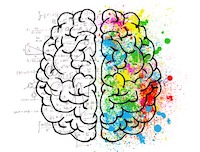- Psychological Safety: An overview. For the science, see the SAFETY model. For Google's research into why it's important for high performing teams, see Project Aristotle. What happens when we don't have that safety?
- Anxiety and Stress: For the science, see Polyvagal Theory or a description of some neuroscience, illustrated with a bear encounter. To let go of that anxiety, see the Anti-Anxiety toolkit.
- Recommended reading: I'm often asked for book recommendations.
- Generally more about the brain: Cognitive bias, motivation, default mode network, systems 1 & 2 and neurotransmitters (chemicals) that drive behaviour.
- Language patterns: Why language is so important, and Clean Language, a specific language pattern that has excellent application for coaching.
- Improving your meetings: Specifically retrospectives (my video course), and standups. What if your people won't participate?
- Improving learning: with neuroscience and LEGO.
- Something fun: The millennial whoop, and inattentional blindness.
Workplace stress and anxiety
A few days ago, I was sitting on my back deck working on the laptop. Out of the corner of my eye I saw some movement in front of me and I glanced up, expecting to see one of the many birds that are normally here. Instead I found myself staring at a young black bear that was walking across my lawn towards me.
Outcome bias (Resulting)
When I first read How to Decide: Simple Tools for Making Better Choices by Annie Duke, one of my biggest aha moments was from what she calls Resulting and is more formally known as Outcome Bias.
“Assume positive intent”
When dealing with troublesome or difficult situations, someone will often chime in with the advice “assume positive intent”. Sometimes teams will even bake this into their working agreements as something they should always do. While I really do like the sentiment, if taken literally as a hard rule, this can be dangerous advice.
Perverse Incentives: Coffee Badging
I learned a new term today: “Coffee Badging”. This is when a company has mandated that people be in the office, so they travel in to the office, swipe their badges, grab a coffee and perhaps talk to someone, and then head home again, where they remain for the rest of their working day.
Improving Psychological Safety
We talk a lot about psychological safety, but most of it is platitudes: “It’s good. Do more of it.”
Tuckman model of team development
I was once called in to help a team, six months into a three month project. Yes, you read that correctly. It was supposed to be a three month project and after six months they had lots of code but nothing that actually worked, and no end in sight.
Playful learning with LEGO
Last week at Agile Open Canada, I brought out the LEGO again, to illustrate technical practices. While there is so much we can do effectively remotely, there are some things that really do benefit from being together in the same room, and this is one of them.
Ladder of Leadership
Sometimes our people aren’t taking initiative in the way we hope they will. This could be due to an issue of motivation or a lack of safety or more generally a system that discourages that initiative in some way. Whatever the reason might be, we need a way to change the conditions to get the result we want.
Dopamine and Learning
In order for us to learn something new, we need to store it in long term memory. If we’re unable to save it there, then we’ll immediately lose that learning the moment we focus our working memory on something new. Working memory is quite limited1 so we need to save those memories quickly if we’re going to.
Autonomy
I’ve spoken to a number of people recently who have complained about a lack of autonomy at work. They talk about being micro-managed by their bosses. About being given solutions to implement, rather than problems to solve. About restrictions on what they can and cannot do in the environment.
